If you’re planning a visit to Chiricahua National Monument, this guide will help you make the most of its hoodoos, trails, and night skies. You’ll get practical details on getting there, where to hike, and what wildlife to expect, plus tips on camping and nearby services. Start here to shape your trip—and find the best viewpoints and ranger programs that are easy to miss.
About Chiricahua National Monument and Where It Is
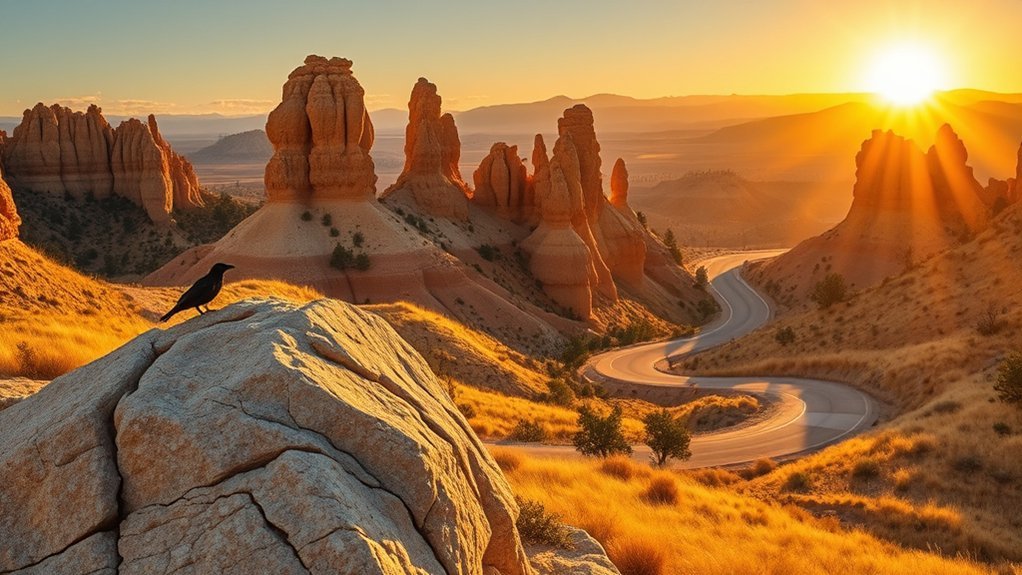
Chiricahua National Monument sits in southeastern Arizona, about 70 miles from the Mexican border and roughly 120 miles from Tucson, preserving over 12,025 acres of rhyolite hoodoos within the Coronado National Forest. You’ll find a unique landscape of spires and balancing rocks that illustrates remarkable geological features formed by ancient volcanic activity. The monument was established in 1924 to protect these formations and related cultural history, yet you won’t need to travel far for services: the closest town is Willcox, about 37 miles northwest. Because Chiricahua lies where Chihuahuan and Sonoran influences meet, you’ll encounter diverse wildlife and plant species across elevational zones. Plan visits knowing trails and viewpoints highlight key formations while minimizing impact on this fragile environment.
History and Cultural Highlights
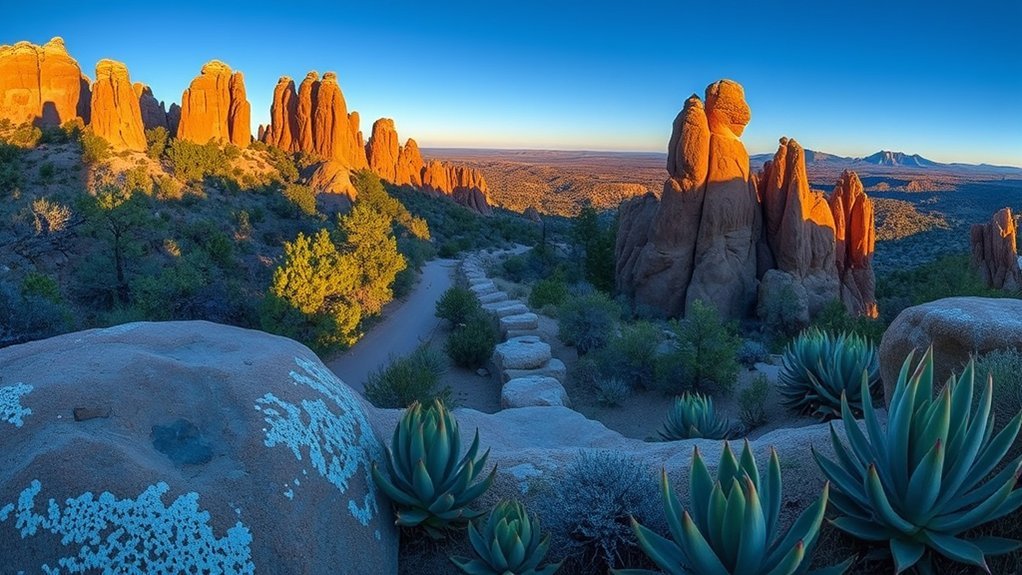
You’ll encounter evidence of Chiricahua Apache heritage throughout the Monument, where the people long called this place the “Land of Standing-Up Rocks” and leaders like Cochise and Geronimo shaped its history. You’ll also learn how Faraway Ranch, founded around 1917, transformed the area into a destination that preserves pioneer life and early tourism stories. As you explore, notice how Indigenous history and ranching-era artifacts together tell the region’s layered cultural story.
Chiricahua Apache Heritage
Because this land has sheltered people for more than 12,000 years, the monument’s towering rock formations are as much cultural landmarks as they are geological wonders. You’ll learn that the Chiricahua Apache people call this place The Land of Standing-Up Rocks and consider it part of their historical homeland. The park was established to preserve both natural beauty and cultural history tied to leaders like Cochise, Geronimo, and Mangas Coloradas, who resisted 19th-century incursions. You can connect with living traditions and seasonal cycles — including the nearby Sandhill Crane migration — that tie wildlife to human story. Focus your visit on respectful interpretation, and use trails, exhibits, and ranger talks to deepen your understanding.
- Respect heritage
- Learn leaders’ stories
- Observe migrations
Faraway Ranch History
Though established around 1917 as a guest ranch, Faraway Ranch quickly became a gateway that introduced early visitors to the monument’s dramatic landscape and pioneer life. You’ll find preserved 19th-century buildings along Bonita Creek—the family home, stables, and outbuildings—that illustrate pioneer life and the ranch’s evolution as a hub for early tourists. Faraway Ranch helped promote Chiricahua National Monument’s natural beauty and rustic charm through decades of hospitality until 1970. The site also sits within a landscape shaped by the Chiricahua Apache and the resistance of leaders like Cochise and Geronimo, reminding you of deeper regional history. Ranger-led programs interpret these themes, connecting you directly to the ranch’s cultural and tourism history.
Geology: The Hoodoos and How They Formed
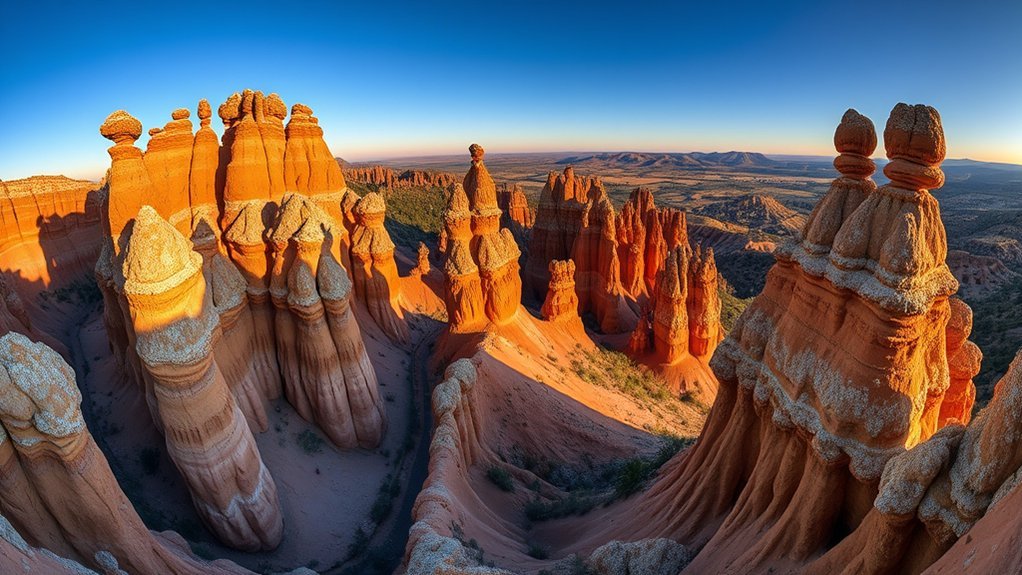
Millions of years ago, violent volcanic eruptions showered the Chiricahua region with ash and pumice that later welded into a layered rhyolite tuff, and those layers are what you see today as hoodoos. You’ll notice the rhyolite tuff’s stratified look across pinnacles and balanced rocks, evidence of intense volcanic eruptions about 27 million years ago. Erosion processes — wind, rain, freeze-thaw — sculpt those layers into the Wonderland of Rocks, producing over 400 distinct rock formations. As you walk, consider three key factors shaping this landscape:
- Deposition: ash and pumice welded into cohesive tuff.
- Lithification: cooling and layering created durable strata.
- Erosion: continual wearing formed columns, pinnacles, and balanced rocks that define these geological features and their natural beauty.
Planning Your Visit: Hours, Fees, and Getting There
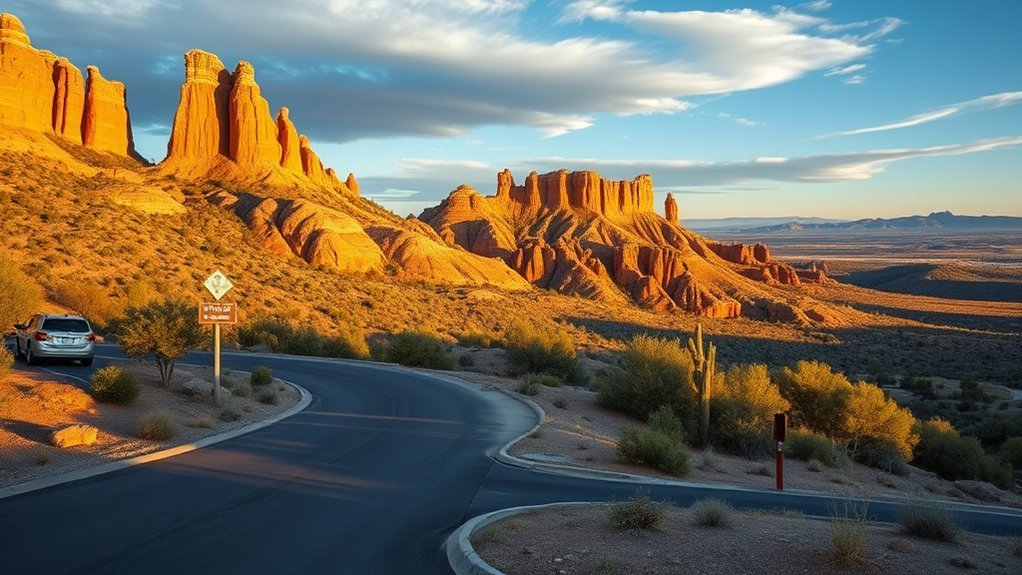
After you’ve admired the hoodoos and learned how wind, water, and time carved the Wonderland of Rocks, you’ll want practical details to plan your visit. Chiricahua National Monument is open 24/7, while the visitor center operates daily from 8:30 a.m. to 4:30 p.m. for maps, permits, and questions. Admission is free, so you can focus on logistics rather than fees. It’s a remote destination in Cochise County, Southern Arizona — about 120 miles from Tucson and roughly 70 miles from the Mexican border. The nearest town with services is Willcox, 37 miles northwest. Recommended driving routes: I-10 East from Tucson to Willcox, then Arizona State Highway 186 to State Highway 181. Plan supplies accordingly when planning your visit.
Hiking Trails and Scenic Drives
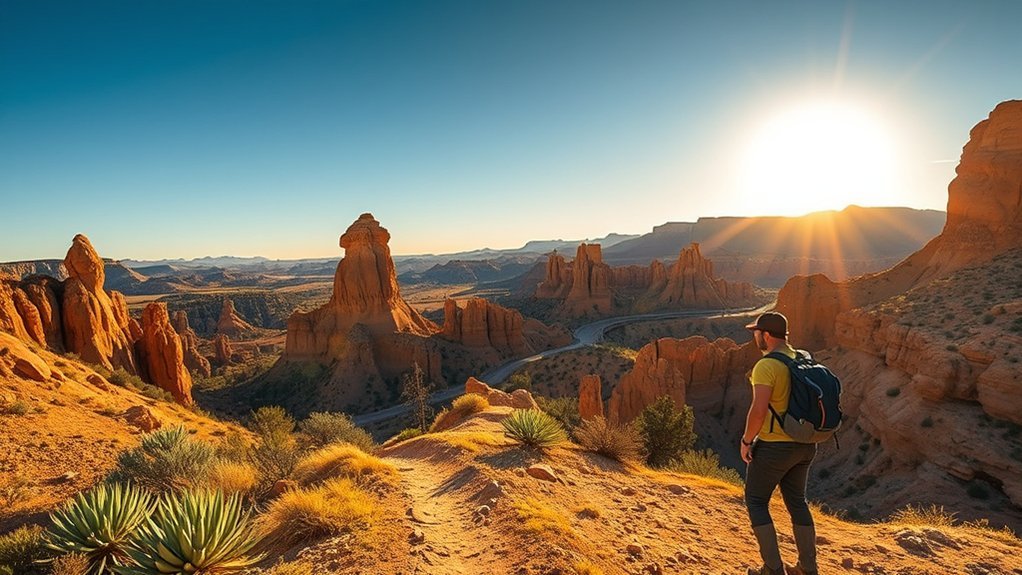
While you’re here, explore Chiricahua’s 17 miles of trails and an 8-mile scenic drive that together showcase the monument’s soaring hoodoos, balancing rock fins, and wide viewpoints. You’ll find hiking trails for all levels: the easy Massai Point Nature Trail, the moderate Echo Canyon Loop Trail, and longer routes through the Heart of Rocks. Drive Bonita Canyon Drive to gain elevation, stop at picnic areas, and reach Massai Point for 360-degree views of the Chiricahua Mountains and distant ranges. The Echo Canyon Loop Trail is about 3.3 miles and best done counter-clockwise in 2–3 hours. Early morning or late afternoon are prime times for wildlife observation and photographing the stunning rock formations that define this landscape.
- Massai Point Nature Trail
- Echo Canyon Loop Trail
- Bonita Canyon Drive
Camping, Lodging, and Nearby Services
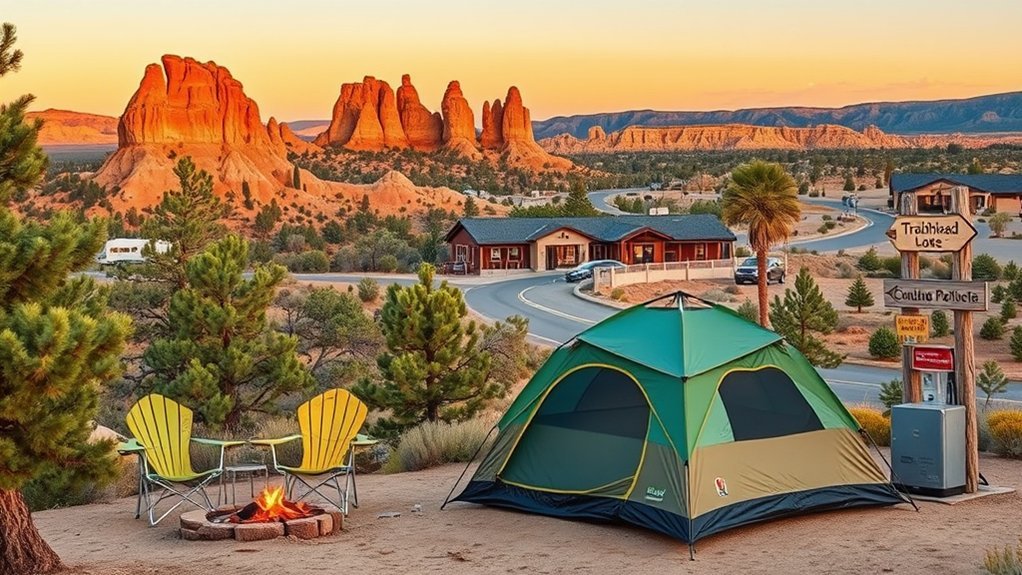
As you plan hikes or a scenic drive through Chiricahua’s rock gardens, you’ll also want to sort out where you’ll sleep and stock up on supplies. Bonita Canyon Campground is the only campground inside the monument: 25 sites, basic amenities (restrooms, potable water), shaded spots, picnic tables and fire pits for family camping experiences. Sites cost $25 per night and you must reserve in advance. There are no dining facilities in the park, so look to nearby towns for lodging options, motels and restaurants — Willcox (about 37 miles) has several. If you want solitude, dispersed camping in the Coronado National Forest offers remote settings. Plan logistics: fuel, food and reservations before you arrive to guarantee a smooth stay.
Wildlife, Birdwatching, and Seasonal Events
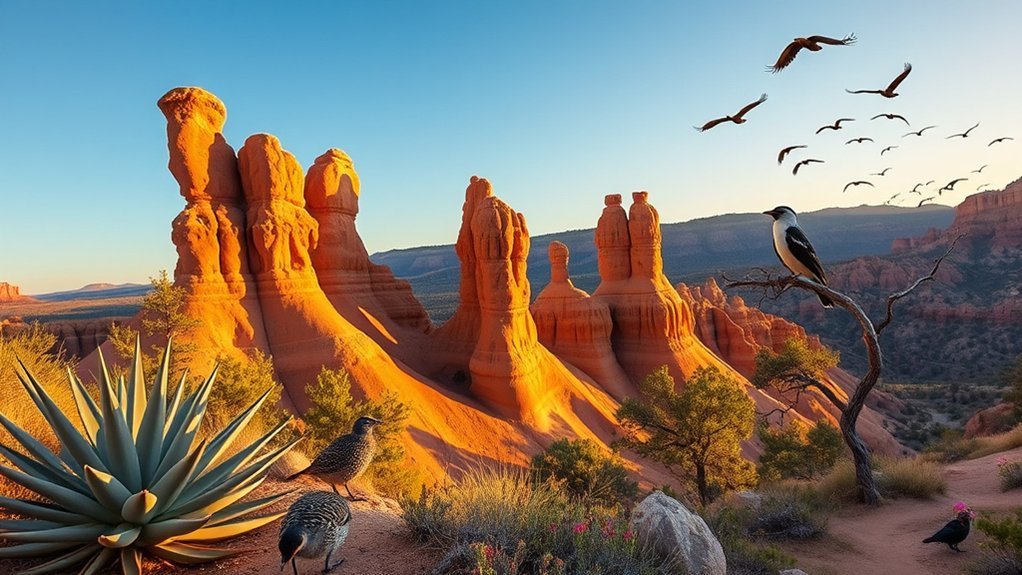
You’ll find more than 200 bird species here, and the park’s Important Bird Area status and the annual Wings over Willcox festival each January make Chiricahua a top birding destination. Keep an eye out for reintroduced Goulds wild turkeys and morning or evening sightings of Coues white-tailed deer, black bears, javelinas, and coatimundis. Seasonal highlights also include Arizona Sisters butterflies and Desert Tarantulas, so plan your visit around peak migration and activity times for the best wildlife viewing.
Key Wildlife to Spot
Many visitors come for the rock spires, but the Chiricahua’s wildlife is an equally compelling draw, and you can spot over 200 bird species along with a range of mammals, reptiles, and insects. You’ll explore Chiricahua National Monument’s diverse habitats—piñon-juniper, oak woodland, and riparian pockets—that support remarkable biodiversity and its Important Bird Area status. Look for Coues white-tailed deer grazing at dawn, wary javelinas, and occasional black bears or mountain lions sign; sightings are most likely in early morning or late afternoon. Reptiles, Arizona Sisters butterflies, and desert tarantulas add intrigue. For concentrated birdwatching, plan side trips to Ramsey Canyon Nature Preserve. Keep these priorities in mind while observing responsibly:
- Scan riparian corridors for hummingbirds and warblers.
- Watch trailsides for mammals and tracks.
- Check rock ledges for lizards and insects.
Birding Seasons & Events
Whether you’re timing a spring migration or a quiet summer morning, Chiricahua’s birding calendar offers reliable windows for sightings and organized events. You’ll find Chiricahua National Monument recognized as an Important Bird Area with over 200 species, so birdwatching here is productive year-round. The best months for hummingbirds and nesting activity run April to September, with peak activity in spring and early summer. Ranger-led birding programs and seasonal walks let you study the local avifauna and habitats up close. Gould’s wild turkeys are a distinctive sight on trails and in nearby woodlands. In January, the Wings over Willcox Festival celebrates the sandhill crane migration, drawing guided tours and educational talks focused on migration ecology.
Night Skies, Stargazing, and Ranger Programs
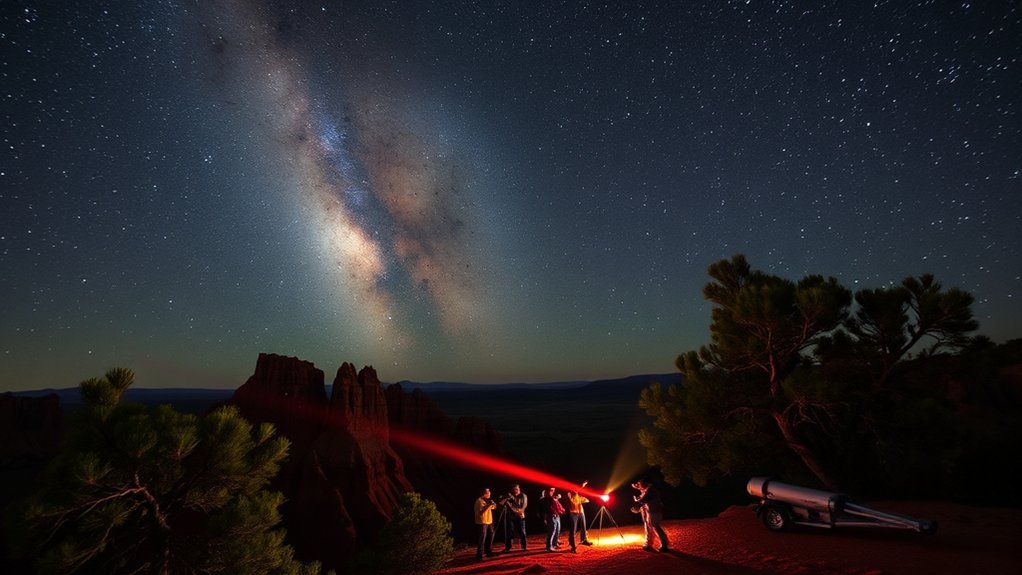
Because Chiricahua is one of Arizona’s 12 International Dark Sky Parks, you can expect some of the clearest, most detailed views of the Milky Way and other celestial sights, especially around new moon nights. You’ll find excellent stargazing across the monument; Massai Point, Echo Canyon Trailhead, and Bonita Canyon Campground offer wide horizons and minimal light interference. The park partners with the Tucson Amateur Astronomy Association for Night Sky Parties, where volunteers bring telescopes and explain celestial phenomena. Ranger-led programs run seasonally, teaching constellations, planets, and observing techniques.
- Plan visits near new moons for ideal Milky Way viewing.
- Attend Night Sky Parties for guided telescope access.
- Check ranger schedules for educational night sky programming.
Frequently Asked Questions
Are Pets Allowed on Trails and in Campground Areas?
Yes — you can bring pets on trails and in campgrounds, but you must follow pet policies and trail regulations. You’re responsible for leash requirements, pet safety, pet waste, avoiding wildlife interactions, and staying in designated pet friendly areas.
Are Fires Allowed Outside Designated Rings and During Fire Restrictions?
Of course you can—if you enjoy fines and ecological damage: you won’t. You must use designated areas, follow campfire safety, firewood regulations, cooking restrictions and park policies, heed seasonal changes, safety guidelines, wildfire prevention and visitor responsibilities.
Is Cell Phone Service Available Within the Monument?
Cell phone service is spotty; you’ll encounter varied cell coverage and weak signal strength. Reception zones favor trailheads, network providers differ, data speeds drop in remote areas—carry communication devices, use emergency calls sparingly, follow technology tips.
Are Bicycles or E-Bikes Permitted on Hiking Trails?
No, you can’t ride bicycles or e‑bikes on hiking trails; bicycle regulations restrict them to roads and parking facilities. Follow e bike guidelines, prioritize trail safety, respect wildlife, consider rentals, and limit environmental impact for better visitor experiences.
Is There Accessibility Information for Visitors With Mobility Impairments?
Don’t worry — you’ll find accessibility information: accessible trails, wheelchair rentals, parking options, restroom facilities, visitor centers, assistance animals, guided tours, mobility aids, trail surfaces, and event accessibility are detailed so you can plan with confidence and independence.
Conclusion
You’ll leave Chiricahua feeling like you’ve stepped onto another planet — and you’ll be right. The hoodoos, wildlife, and starry skies will stubbornly lodge in your memory, demanding you return. You’ll hike, learn from rangers, and find quiet corners that seem too perfect to be real. Plan well, respect the land, and you’ll walk away with stories that sound exaggerated — until friends see your photos and won’t doubt you for a second.

